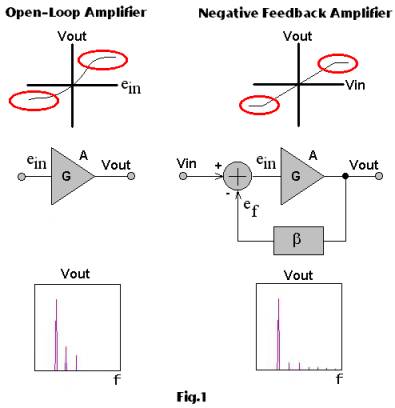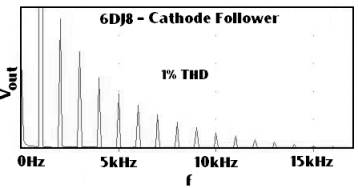|
|
Cathode Follower follows Audio?
Introduction
Cathode
Follower stages (CF) are widespreadly used in the audio design but with
an high rate of controversial.
What’
the reason?
The
opponents recognize in th CF an harsh sound and ascribing the
reason to the presence of 100% of Feedback Factor. Therefore the use of this
circuit topology (as well as any amplifier with overall feedback) must be
avoided in a true hi-fi amplification system.
The
supporters claim that this concen is unjustified because the involved
Negative Feedback acts only locally then sonic degradation is assent. Further CF
stages have unique properties as good
current and impedance matching capabilities.
But,
do the cathode follower unaffects the sonic texture really, or its use must be
evaluated with care?
In
this article I’ll try to reply this question.
The “Looped”
Block
Any
feedback amplifier can be modeled with the block diagram in Fig.
1 (right
side).

I
assume the exempliphying hipothesys the the open-loop amplifier A
have a non-linear behaviour modeled with a second order input-output
characteristic:
![]() (1)
(1)
When you apply the Negative Feedback you obtain:
![]() (2)
(2)
By
solving eq.(2) with respect
to
ein
you
obtain:
 (3)
(3)
where:

The square-root in eq.(3) can be approximated with
the following expression:
![]()
(4)
Then
the signal in output to the feedback amplifier is a power-series expansion
of the input signal: a very interesting result!
In
fact altough the amplifier A in its open-loop state
yields only second-order effects, the feedback amplifier in reducing
the distortion extends dramatically the harmonic spectrum, i.e. the
feedback amplifier has less distortion of the open-loop one but the harmonic
spectrum of the former is richer in harmonics.
You have other factors that make worse this
situation.
First,
the feedback factor g is frequency dependant and decrease with and, for
the same definition of factor
a the high order terms in eq.(4) increase with the frequency. This reflect
one of major troublesome aspect of feedback amplifier because you can see g the magic term for this circuit topology (for example with g
you can artificially affect the closed loop gain, the input and output impedance
and so on).
Second,
the complexity of eq.(4) increases when you realistically assume that the
input-output relationship for the open-loop amplifier have an higher order.
This
artful behaviour of negative feedback amplifiers could be one of the aspects
correlated with the timbric alteration that some people seem to notice during
the listening in critical situations.
The Cathode
Follower Stage

Fig.2
I’ll
lead a similar analysis for the circuit topology depicted in Fig.2.
By
assuming:
![]() (5)
(5)
since:
 (6)
(6)
through
algebraic calculi you obtain the following expression for the voltage eg:
 (7)
(7)
where:

The
eq.(7) underlines that the cathode folllower stage presents a non-linear
behaviour exactly alike an overall negative feedback amplifier (really, after the results obtained with the eq.(7) you can
state that a more complex relationship between the voltages Vin
and
Vout exists).

Fig.3
Fig.3,
depicts the harmonic spectrum of a CF stage build with a 6DJ8
vacuum tube. You can observe a large harmonic content counterbalancing a
relatively low THD. Some audio designers are deeply convinced about the
harfulness of this behaviour then refuse tout-court this circuit topology.
Others share this worry but observe
that the degenerative phenomenon summarized by eq.(7) yields effects only when
signal swings are elevated and therefore if border effects are evaluated
attentively the benefits surclass the disadvantages.
In
accordance with this last viewpoint a CF stage can result irreplaceable in the
impedance matching, in the reactive loads driving
and when you want a low cost
driver in a grid currents context (classes A2, AB2).
Conclusions
Is
the Cathode Follower audio-compliant?
You can reply in a more solid manner at this point. The input-output relationship of this stage is the same of a true feedback amplifier and therefore harmful in the potential but this worry is motivated when voltages and/or currents are high. In the signal amplification domain, i.e. in the design of Phono and Line Preamplifiers, this cannot be matter of concern. When large signal are involved as in the power amplification its use must be attentively evaluated and compromises are inevitable.
|
What did you
think of this article? |